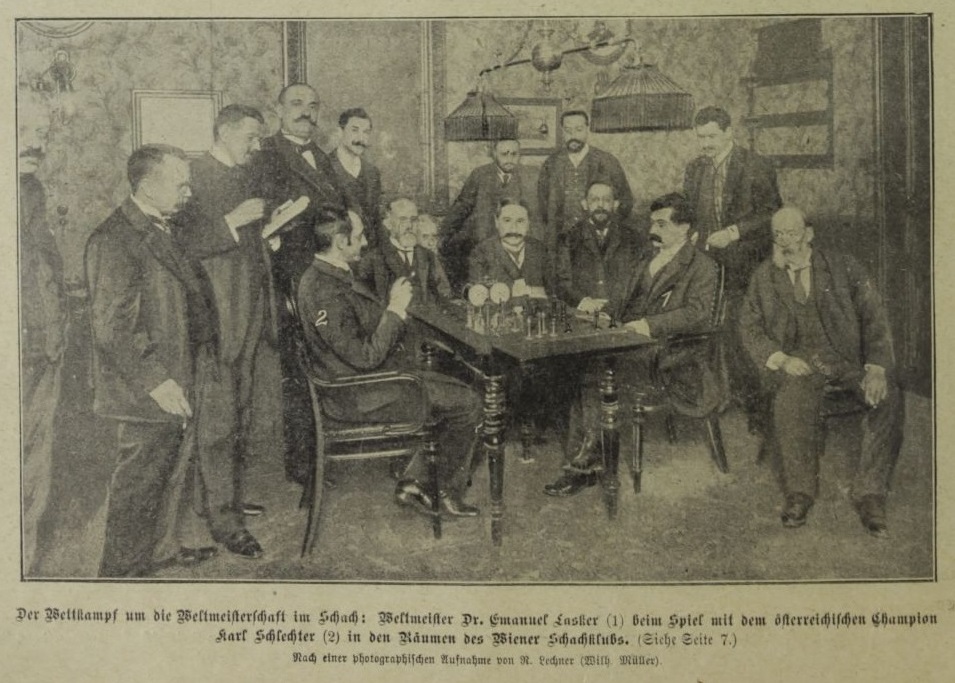
Edward Winter

Das interessante Blatt, 20 January 1910, page 6
As noted by Michael Lorenz (Vienna) in C.N. 11584, the photograph was published with a full caption on page 59 of the February-March 1910 Wiener Schachzeitung:
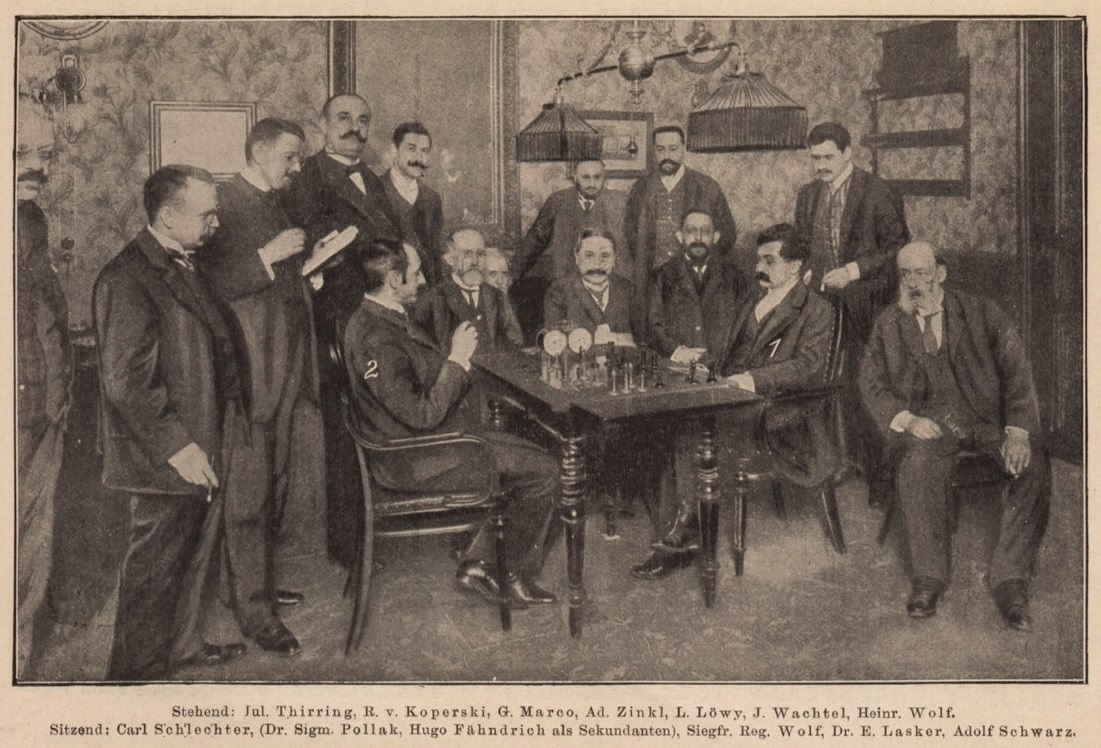
What were the conditions for the ten-game match in 1910 between Emanuel Lasker and Carl Schlechter? In particular, did Schlechter have to win by a two-point margin to gain the world title? Since 1982, a series of C.N. items has considered these matters and has examined the concluding game, which Lasker won.
***
An odd, and unresolved, mystery arises from page 51 of the November 1975 edition of CHESS. E.A. Apps was presenting some (inconclusive) research on the Lasker-Schlechter controversy (did Schlechter need to win the 1910 world championship match by two clear points in order to gain the title?). He mentioned a number of eye witnesses who supported the ‘one-point theory’, and these included Dr Perlis:
‘Dr Perlis was one of Schlechter’s closest friends and obtained a higher score than Schlechter in the 1909 St Petersburg tournament. In 1914, and again in 1920, Dr Perlis published that he was profoundly convinced that ... “Schlechter does not seem to have taken part in the argument, but some believe that he inspired his friend Dr Perlis to put these statements out.”
If he did, then it was the inspiration of the century. Dr Perlis had died, from a mountaineering accident, in September 1913.
A contribution from Louis Blair (Carlinville, IL, USA) concerns the tenth match-game between Lasker and Schlechter in 1910:
‘According to Part I of My Great Predecessors (page 183), the game was adjourned at 32...Qh5+ “(or a move earlier) ... and resumed the following day”.
Pages 186-190 of the March 1976 issue of CHESS state: “15 g4 ... was Lasker’s sealed move at the end of the day’s play. ... on Wednesday, 9 February 1910 ... Lasker made sealed moves at move 29 for the ‘tea recession’ and at move 43 for the ‘dinner recession’. … Lasker made the sealed move 58 Ka2 at about 11 p.m. 9 February 1910. This was the second and final adjournment.”
Of course, Kasparov and CHESS are not primary sources. Pages 163 and 165 of the April 1910 issue of the BCM mention adjournments after Lasker’s 15th and 58th moves.
It seems to me that this issue is of some interest because an adjournment at move 43 might offer a possible explanation (time pressure) for Schlechter’s famous mistake at move 39.’
One of the more reliable primary sources of the time was Deutsches Wochenschach, which gave the tenth match-game (played in Berlin on 8, 9 and 10 February) on pages 61-62 and 67 of its 13 February 1910 issue. It stated that after Black’s 15th move the game was adjourned until the next day (‘Hier wurde die Partie abgebrochen und am folgenden Tage fortgesetzt’) and that there was a further adjournment (‘abgebrochen’) after White’s 58th move. Other periodicals consulted by us so far have revealed no complementary details. With luck, a reader will be able to check for possible accounts in local newspapers.
No chess event requires greater caution by historians than the Lasker v Schlechter match. As shown by magazine and newspaper reports of the time, the regulations evolved between late 1908 and early 1910, but, as far as we know, they were never published in a final, consolidated form.
(3179)
Robert Hübner’s unmissable (not to say devastating) review of the first volume of Kasparov’s My Great Predecessors was published in the 11/2003 and 12/2003 issues of Schach (pages 24-35 and pages 34-48 respectively). On page 40 of the latter he discussed this position after White’s 48th move in the final game of the Lasker v Schlechter match (i.e. with respect to pages 185-186 of the English edition of Kasparov’s book):
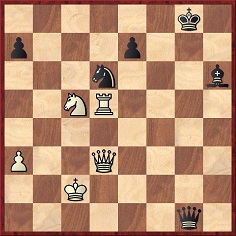
‘There followed 48…Qc1+ 49 Kb3 Bg7 50 Ne6 Qb2+, etc.
In the book under discussion, however, 48…Qf2+ is given as the move played, and after 49 Kb3 Bg7 50 Ne6 Qb2+ it is stated:
“Another mistake that was not pointed out by anyone! 50…Qb6+! was essential, driving the king back to the kingside: 51 Kc2 Qb2+ 52 Kd1 Qa1+ 53 Ke2 Qb2+ 54 Kf3 (…) Qf6+ 55 Nf4 Nf7. Of course, White will play for a win, but with such a king it is doubtful whether such a result can be achieved.”
Yet it is not so astonishing that nobody has pointed out this continuation, for a queen move from c1 to b6 was against the rules of the game at the time.
Incidentally, the entire variation [i.e. up to 55 Nf4 Nf7] was given as an annotation to 48…Qc1+ in Schach, 10/1999, page 47.’
(3180)
Concerning the 1910 Lasker v Schlechter match, the terms of which are an unsolved and probably insoluble mystery, one aspect of the controversy is whether the world championship title was at stake. David Hooper stated on pages 183-184 of the March 1976 CHESS that he did not believe so, and one of his paragraphs read:
‘The American Chess Bulletin, 1910, page 155 writes: “the champion agreed to play a series of games, but it was expressly stipulated that the result was not to touch the title”. I have almost a complete run of this magazine, which Lasker read, and on all other occasions when a comment was published which in any way touched his honour he replied at once: yet on this one occasion he made no comment at all.’
David Hooper was referring to an article by Buckley on pages 155-156 of the June 1910 American Chess Bulletin, but the above-quoted reference to Lasker leaves us flummoxed because a rebuttal by the then world champion was reported within the article itself. [See C.N. 3252 below.] The full text of the relevant passage from Buckley’s article, with the Bulletin Editor’s interjection, is as follows:
‘The result of the late match points to a contest on different terms, a match for the world championship. The ten games lately played constituted a sort of match, but the object was not the settlement of the championship, as many have supposed. If Schlechter had won all the games, Lasker would still have been titular world champion. The champion agreed to play a series of games, but it was expressly stipulated that the result was not to touch the title.
This consideration affects opinion of the result.
(In reply to a query on board the SS Vasari, on 20 May, Dr Lasker, southward bound, said, “Yes, I placed the title at stake”; thereby confirming our understanding of the matter. Notwithstanding this, we can well believe that, owing to the unusual circumstances of the match, many people would have continued to regard Dr Lasker as champion, even had he lost that final game. Ed., ACB.)’
(3249)
Our item above [C.N. 3249] did, by omission, an injustice to Louis Blair, as we had forgotten that in an October 1989 letter to us he pointed out the discrepancy (to use no stronger word) between the American Chess Bulletin’s 1910 item and David Hooper’s reference to it in CHESS (1976). Mr Blair also discussed the matter in an article entitled ‘The Lasker-Schlechter match: a new look at the published evidence’ on pages 48-55 of the February 1990 BCM.
(3252)
The 1910 Lasker v Schlechter controversy (was it a world championship match and, if so, did Schlechter have to win by two points to gain the title?) has been referred to, inconclusively, in several C.N. items. Now Richard Forster (Winterthur, Switzerland) submits the following report by Walter Preiswerk (who was then in Leipzig) in the Basler Nachrichten of 20 February 1910, i.e. ten days after the Lasker v Schlechter match ended (+1 –1 =8):
‘... Man nahm nun allgemein an, die letzte Partie werde mit remis enden, und Schlechter werde sich dadurch den Sieg sichern. Aber merkwürdigerweise gewann Lasker und machte so den Wettkampf unentschieden. Es ist wirklich seltsam, dass Schlechter, der von 9 Partien keine verlor, nun gerade in der letzten unterlag, und die Annahme, dieser Ausgang sei beabsichtigt gewesen, liegt nahe. Ein knapper Sieg Schlechters hätte diesem nämlich keineswegs die Weltmeisterschaft eingebracht, sondern einen ernsten Revanchekampf zu Folge gehabt, der ohne Rücksicht auf seine Finanzierung hätte ausgetragen werden müssen. Dies mag beiden Meistern, die ja auch ausgezeichnete Geschäftsleute sind, nicht gepasst haben. - Das Resultat des Matchs ist übrigens die konsequente Folge seiner Bedingungen, und man könnte ihm den Wahlspruch geben: “Tu mir nichts, ich tu dir auch nichts!”’
It is difficult to know quite what to make of this commentary. Below, in any case, is our English translation:
‘It was generally assumed that the last game would end in a draw and that Schlechter would thereby ensure victory for himself. Curiously enough, however, Lasker won, which meant that the match ended indecisively. It is very strange that Schlechter, who lost none of the first nine games, succumbed in the final one, and the assumption suggests itself that this outcome was intentional. A narrow victory by Schlechter would by no means have given him the world championship but, instead, it would have brought him a serious return match to be carried out irrespective of its financing. This may not have suited the two masters, who, after all, are also excellent businessmen. The result of the match is, incidentally, the logical consequence of its conditions, and it could be accorded the motto, “Do not kill me, and I shall not kill you”.’
(4144)
‘Lasker and Schlechter signed a secret protocol’ is the heading on page 46 of The Genius and the Misery of Chess by Zhivko Kaikamjozov (Newton Highlands, 2008), and the following page affirms:
‘The match rules [i.e. for the 1910 encounter] weren’t published anywhere and the above-mentioned clauses were secret, known only by the players and two confidants. The protocol from the match was revealed much later, after the death of the last of the four men who knew the secret.’
Naturally the ‘two confidants’ are left unidentified, as is the person who revealed the ‘protocol’, as well as everything else that the reader would expect to be told.
(5855)
From page 29 of The Chess Scene by D. Levy and S. Reuben (London, 1974):
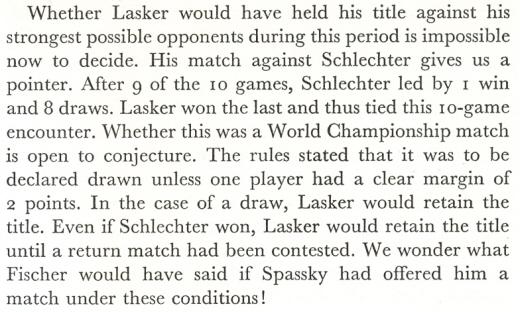
Corroboration provided by the co-authors for these statements: zero. See also, for instance, page 127 of Grandmasters of Chess by Harold C. Schonberg (Philadelphia and New York, 1973).
The concluding paragraph of C.N. 3179 (see page 280 of Chess Facts and Fables) may be recalled:
‘No chess event requires greater caution by historians than the Lasker v Schlechter match. As shown by magazine and newspaper reports of the time, the regulations evolved between late 1908 and early 1910, but, as far as we know, they were never published in a final, consolidated form.’
Anyone wishing to make a careful analysis of such questions as whether Schlechter had to win the match by two points and whether the world title was at stake should evidently begin by studying existing accounts of the controversy. We list below the main items that come to mind, many of which cite material published in 1908-10.
June 1974, page 206 (B. Cafferty);
October 1974, page 379 (J.M. Brown, E. Winter, R. Sinnott);
January 1975, page 26 (W. Heidenfeld);
April 1975, pages 162-163 (D. Brandreth);
August 1975, page 353 (W. Heidenfeld and E.A. Apps).
July 1975, pages 294-295 (W. Heidenfeld);
August 1975, pages 327-328 (D. Hooper, W. Heidenfeld);
September 1975, pages 357-358 (R.E. Gill, A. Penrose, W. Heidenfeld, H. Fraenkel);
November 1975, pages 48-49 (K. Whyld);
March 1976, pages 180-191 (E.A. Apps, W. Heidenfeld, C.D. Robinson, D. Hooper);
June 1976, pages 283-285 (E.A. Apps, H. Lyman);
September 1976, pages 380-381 (K. Whyld, W. Heidenfeld).
The South African Chessplayer, February 1986, page 26 (K. Whyld).
New in Chess, 1/1995, pages 5-6 (L. Blair);
New in Chess, 3/1995, pages 5-6 (D. Brandreth).
New in Chess, 8/1995, pages 7-8 (L. Blair).
(7109)
In C.N. 81 we commented:
The whole controversy is a curious one, for evidence tends to point one way, common sense the other.
C.N. 394 (see page 234 of Chess Explorations) gave some quotes from Draw! by Wolfgang Heidenfeld (London, 1982), including the following from pages 26 and 30, with regard to the seventh match-game, Schlechter v Lasker, Berlin 1910:
‘It is probably the most profound game ever played in a world championship match.’
‘And yet there are people who maintain that Karpov and Korchnoi are stronger than Lasker and Schlechter. They must be joking.’
Page 42 of Evans on Chess by Larry Evans (New York, 1974):
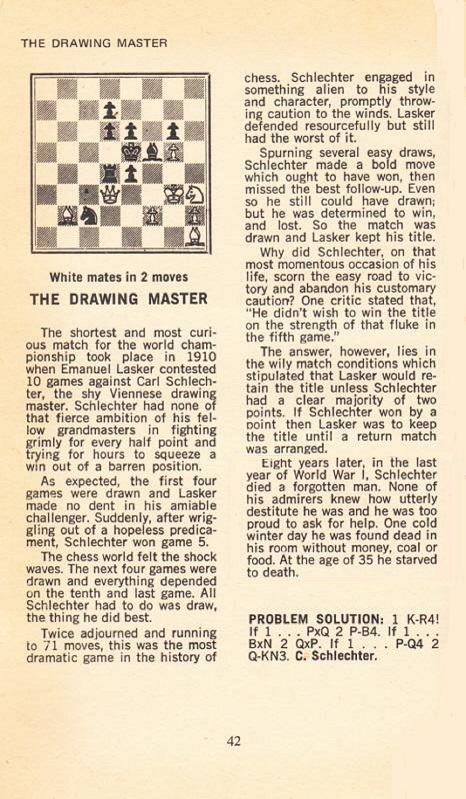
As regards the final paragraph, at the time of his death, in late December 1918, Schlechter was by no means ‘forgotten’; he was the Editor of the Deutsche Schachzeitung and in September-October 1918 had participated in a double-round tournament in Berlin with Lasker, Rubinstein and Tarrasch. His death occurred not ‘in the last year of World War I’ but after the War was over. Nor was he found dead alone in his room at home (which would mean in Vienna); he died in hospital in Budapest. The cause of his death is uncertain. He was then aged 44, not 35.
That syndicated column by Evans, riddled with errors though it was, was still appearing in newspapers nearly 15 years after its first publication (on, for instance, page D27 of the Chicago Tribune, 3 May 1987), without even a correction of Schlechter’s age.
Nor, of course, was there ever an admission that the article was heavily reliant on a piece about Schlechter by Heinrich Fraenkel published on pages 50-53 of Chess Treasury of the Air by Terence Tiller (Harmondsworth, 1966) and reprinted on pages 5-6 of the January 1970 Chess Digest. Below is the final paragraph from the book:
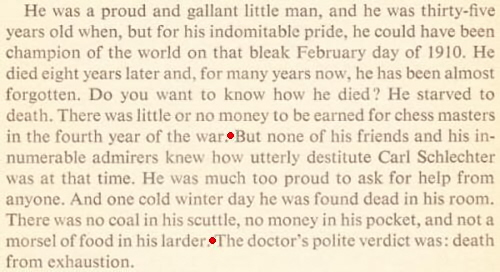
It is obviously unwise to rely on such material without independent corroboration, but Evans relied on it without even reading it properly. Fraenkel stated, correctly, that Schlechter was aged 35 at the time of the match against Lasker, and not when he died, and he referred to Schlechter being almost forgotten ‘for many years now’ (i.e. from the standpoint of the mid-twentieth century), and not at the time of his death.
Despite cribbing from Fraenkel, Evans contradicted him concerning the terms of the Lasker v Schlechter match (for Fraenkel was the ‘critic’ mentioned anonymously three paragraphs from the end of Evans’ article). He also wrote simplistically and categorically about the match on page 49 of The Chess Beat, again with no apparent understanding of what is one of the most complex puzzles in chess history. It is not by chance that criticism of Evans’ published output increased during his later years, as he eschewed writing about chess play (in which he held the grandmaster title) and preferred writing about chess history, lore and politics (in which he held himself up to ridicule).
On pages 45-50 of Carl Schlechter! Life and Times of the Austrian Chess Wizard (Yorklyn, 1994) Warren Goldman discussed Schlechter’s demise in detail, noting that possible causes of death were lung disease aggravated by lack of proper nutrition, tuberculosis, pneumonia and the Spanish flu epidemic. On page 46 he wrote:
‘Published accounts concerning the medical details are fragmentary and do not allow a firm conclusion as to the precise cause of death.’
Pages 428-452 of the Goldman book sifted the evidence regarding the conditions for the 1910 Lasker v Schlechter match. Again, no definitive conclusions could be offered.
That is how proper writers (not only historians, of course) work. When they know, they explain why they know. When they are uncertain, they explain why they are uncertain. When they do not know, they either say that they do not know or they say nothing. That is honest writing which treats the reader with respect, and there is no other kind worth doing.
(8222)
Emanuel Lasker – Carl Schlechter
Tenth match-game, Berlin, 8, 9 and 10 February 1910
Queen’s Gambit Declined
1 d4 d5 2 c4 c6 3 Nf3 Nf6 4 e3 g6 5 Nc3 Bg7 6 Bd3 O-O 7 Qc2 Na6 8 a3 dxc4 9 Bxc4 b5 10 Bd3 b4 11 Na4 bxa3 12 bxa3 Bb7 13 Rb1 Qc7 14 Ne5 Nh5 15 g4 Bxe5 16 gxh5 Bg7 17 hxg6 hxg6 18 Qc4 Bc8 19 Rg1 Qa5+ 20 Bd2 Qd5 21 Rc1 Bb7 22 Qc2 Qh5 23 Bxg6 Qxh2 24 Rf1 fxg6 25 Qb3+ Rf7 26 Qxb7 Raf8 27 Qb3 Kh8 28 f4 g5 29 Qd3 gxf4 30 exf4 Qh4+ 31 Ke2 Qh2+ 32 Rf2 Qh5+ 33 Rf3 Nc7 34 Rxc6 Nb5 35 Rc4 Rxf4 36 Bxf4 Rxf4 37 Rc8+ Bf8 38 Kf2 Qh2+ 39 Ke1 Qh1+ 40 Rf1 Qh4+ 41 Kd2 Rxf1 42 Qxf1 Qxd4+ 43 Qd3 Qf2+ 44 Kd1 Nd6 45 Rc5 Bh6 46 Rd5 Kg8 47 Nc5 Qg1+ 48 Kc2 Qc1+ 49 Kb3 Bg7 50 Ne6 Qb2+ 51 Ka4 Kf7 52 Nxg7 Qxg7 53 Qb3 Ke8 54 Qb8+ Kf7 55 Qxa7 Qg4+ 56 Qd4 Qd7+ 57 Kb3 Qb7+ 58 Ka2 Qc6 59 Qd3 Ke6 60 Rg5 Kd7 61 Re5 Qg2+ 62 Re2 Qg4 63 Rd2 Qa4 64 Qf5+ Kc7 65 Qc2+ Qxc2+ 66 Rxc2+ Kb6 67 Re2 Nc8 68 Kb3 Kc6 69 Rc2+ Kb7 70 Kb4 Na7 71 Kc5 Resigns.
Thomas Niessen (Aachen, Germany) submits the above game-score and writes:
‘Lasker published this game in Pester Lloyd in three parts (moves 1-15 on page 8 of the Morgenblatt of 11 February 1910, moves 16-43 on page 2 of the Abendblatt of the same day, and moves 44-71 on page 2 of the Abendblatt of 12 February 1910). Schlechter published the game-score on page 219 of the Allgemeine Sport-Zeitung, 27 February 1910.
The first problem with the score occurs after 48 Kc2:
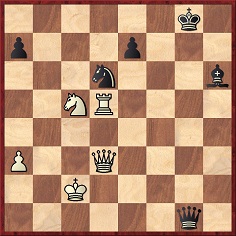
Instead of 48...Qc1+, which was given by both Lasker and Schlechter, some sources have 48...Qf2+. An example is the first volume of Kasparov’s My Great Predecessors, page 185 (C.N. 3180). This mistake was introduced shortly after the game in Deutsches Wochenschach, 13 February 1910, page 67:
The error was also in Národní listy, 15 February 1910, page 4:
The wrong move (48...Qf2+) was given too in Časopis českých šachistů, June 1910, page 97.
Other newspapers reported correctly 48...Qc1+, e.g. Berliner Tageblatt, 11 February 1910 (Morgen-Ausgabe, on the first, unnumbered page of the 1. Beiblatt) The Times, 12 February 1910, page 12.
A second difference in the score appears quite often: instead of 66...Kb6, as Lasker and Schlechter recorded, 66...Kb7 is given. This mistake was also introduced very soon after the game, as is shown by the Nieuwe Rotterdamsche Courant, 12 February 1910 (Avondblad, B, page 1). None of the 1910 sources that I have mentioned contains both mistakes, but Chessbase Online Database, NICBase Online, chessgames.com and 365chess.com currently all do, as does Kasparov’s book referred to above (pages 185-186).
Both mistakes are also on page 854 of Emanuel Lasker: Denker, Weltenbürger, Schachweltmeister by Richard Forster, Stefan Hansen and Michael Negele (Berlin, 2009), although pages 61f. and 67 of Deutsches Wochenschach 1910 are given as its sources.
Lasker himself published a different score in Ost und West, April 1910, pages 236-237. Firstly, he saved a move with 31...Qh5+ 32 Rf3, instead of 31...Qh2+ 32 Rf2 Qh5+ 33 Rf3, and secondly he gave a different order for the moves 45-50, compared to moves 46-51 in Pester Lloyd.’
Hans Renette (Bierbeek, Belgium) provides the chess column on page 5 of the 23 December 1908 edition of the New York Evening Post:

This column is significant with regard to the controversy over the conditions for the 1910 Lasker v Schlechter world championship match and has been quoted, inter alia, on pages 162-163 of the April 1975 BCM.

Illustrierte Kronen Zeitung, 15 January 1910, page 7.
Concerning the tenth match-game between Lasker and Schlechter in Berlin, 1910, on page 80 of Kings of Chess (London, 1954) William Winter wrote after 1 d4 d5 2 c4 c6:
‘It is curious that nearly all the contemporary annotators condemned this move. It is, of course, one of the best methods of declining the Queen’s Gambit.’
From the book’s Introduction (page 11):
‘... the solitary Slav Defence played by Schlechter against Lasker’s Queen’s Gambit caused a buzz of astonishment throughout the chess world. One English commentator went so far as to place a note against Black’s second move: “To this weak move may be attributed the loss of the game.” He quite ignored the fact that, at one period, Black held a winning position, but the remark is interesting as indicative of the narrow outlook on the openings during the first decade of the century.’
A spot-check of annotations written in 1910 suggests that the comments in Kings of Chess about the reaction to 2...c6 are an exaggeration. Two rare cases of outright condemnation of the move are on page 130 of La Stratégie, April 1910, attributed to, respectively, Tarrasch and the New Orleans Times-Democrat:
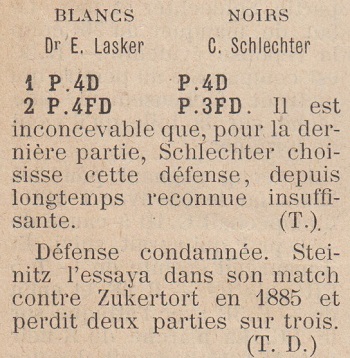
The New Orleans Times-Democrat (13 March 1910, page 9, part three) had not only the incorrect date 1885 but also a longer text whose second and third lines were inverted:

On this topic, see Old Opening Assessments.
(11080)
Ola Winfridsson (São Paulo, Brazil) writes:
‘On pages 38-39 of the 2/1963 issue of Tidskrift för Schack an article by the Swedish correspondence chess grandmaster and botanist Åke Lundquist throws possible light on the contentious issue, often discussed in C.N., of whether a two-point margin was required for Schlechter to win the world championship title from Lasker in 1910. It referred to an article by Gideon Ståhlberg on pages 295-296 of the 10/1962 issue of Tidskrift för Schack which had discussed the final game of the match. Mentioning analysis by Tarrasch and Spielmann, Lundqvist took issue with Ståhlberg’s description of the course of the game and suggested that Schlechter could have drawn with 39...Qh4+. Stating that Schlechter did see that continuation and asking why he did not select it, Lundqvist wrote that there was a possible explanation other than Spielmann’s suggestion of noblesse on Schlechter’s part:
“According to Yudovich in Shakhmaty v SSSR 2/1960, no less than a two-margin of victory had been set as a condition for the title of world champion to change owners. Such a stipulation would, in and of itself, hardly be unreasonable, and Yudovich quotes as proof a contemporary Russian chess periodical.”
Lundqvist added that Spielmann, who ought to have had first-hand information, said nothing about such a clause, but that if Yudovich’s claim were correct, it would explain Schlechter’s play: he had to win the last game to achieve the necessary two-point margin of victory. Lundqvist did not specify the contemporary source quoted by Yudovich. What exactly did Yudovich write in the 1960 Soviet magazine and what was the contemporary source that he gave?’
Vitaliy Yurchenko (Uhta, Russian Federation) has sent us not only the article by Yudovich on pages 53-54 of the 2/1960 Шахматы в СССР but also the source material used by Yudovich, i.e. page 328 of Шахматное обозрение, September 1909, and pages 455-456 of the December 1909 issue:
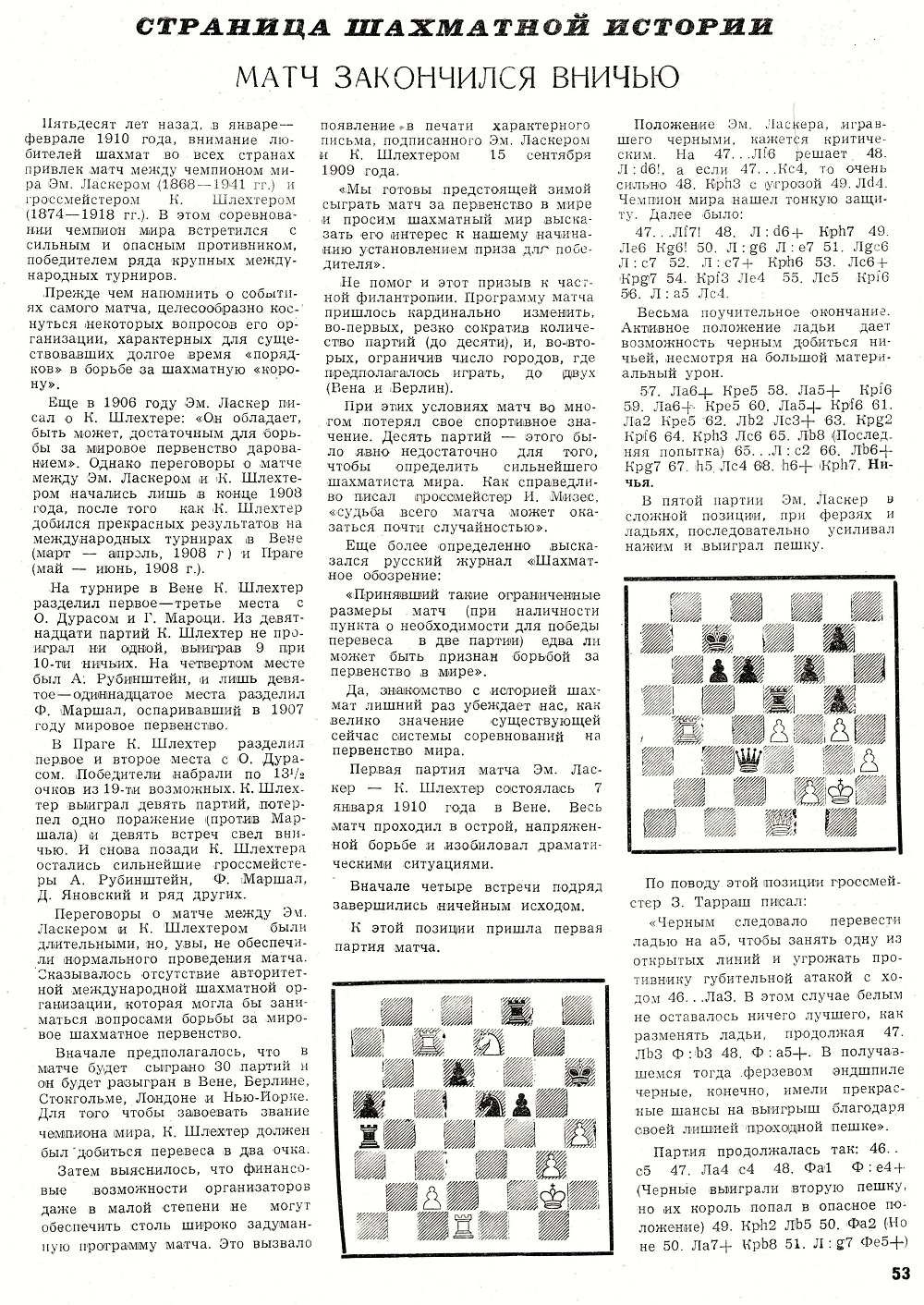
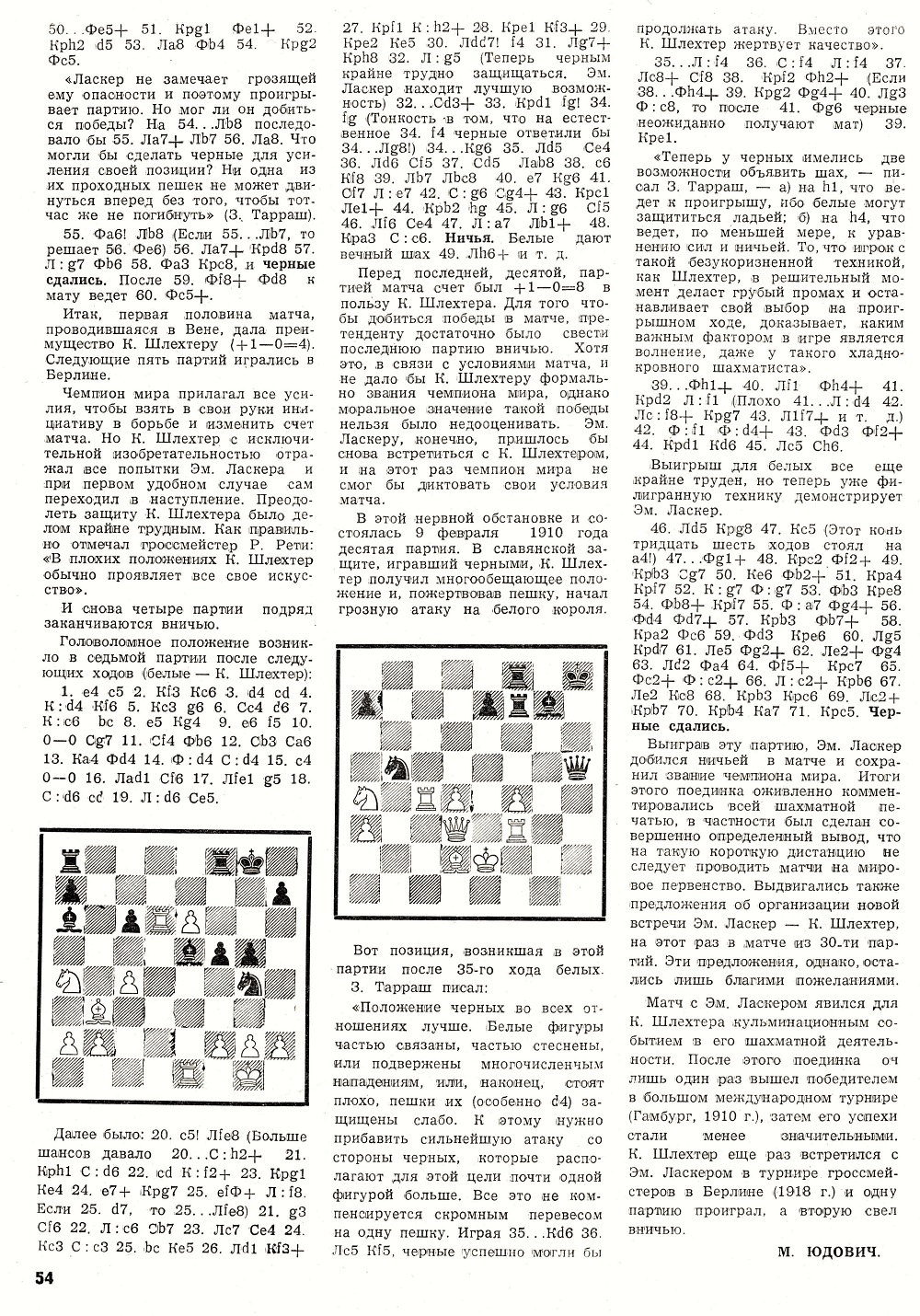
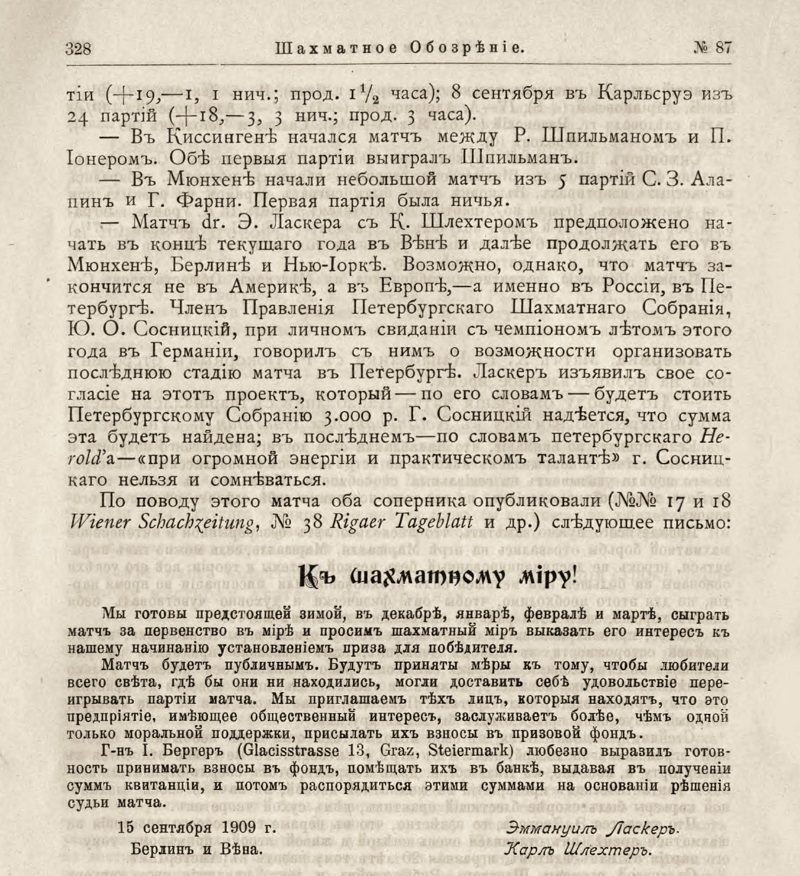
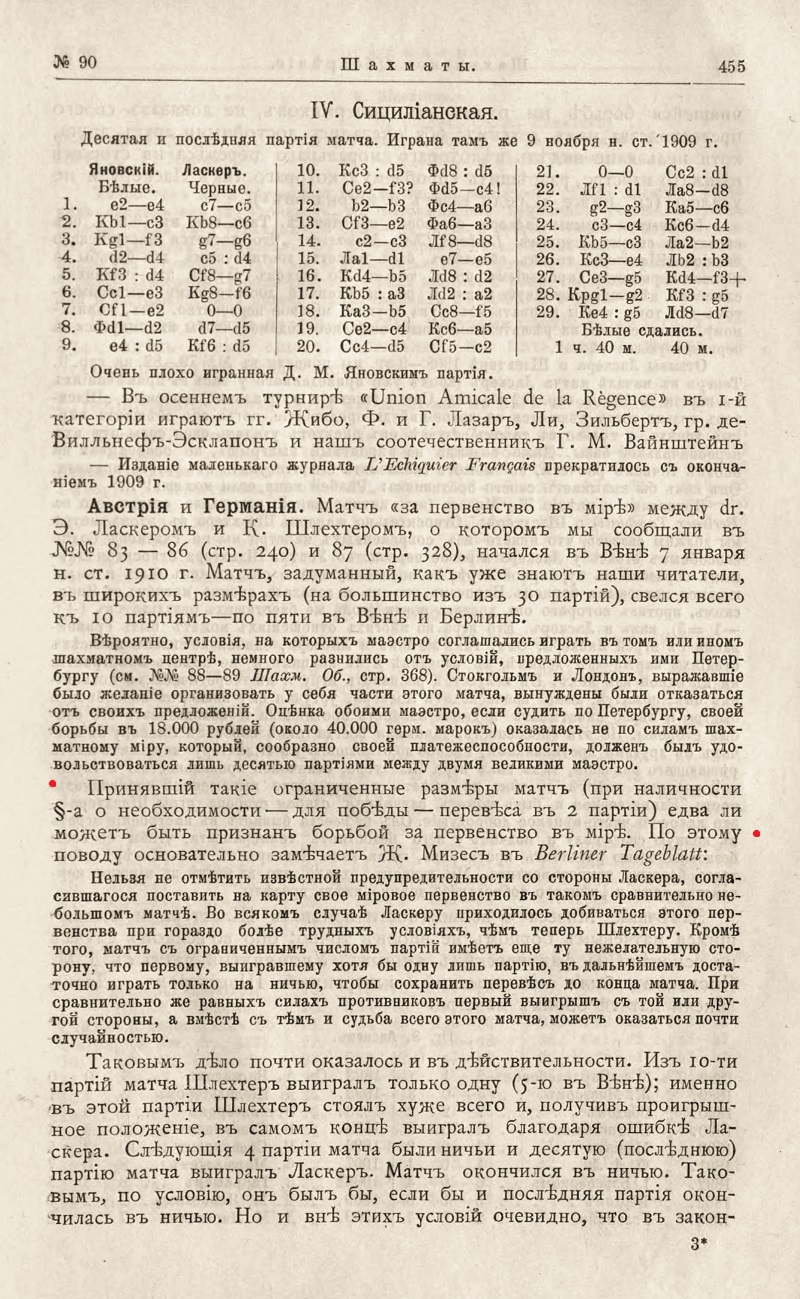

(11305)
Bent Larsen (Buenos Aires) informs us that on a visit to the Holstebro Chess Club in 1947 he found that many of the old club members were certain that Schlechter needed to win the last game of his 1910 match in order to become world champion. It remains to be discovered where, prior to 1960, such a match condition appeared in print.
(2154)
A paragraph about Emanuel Lasker on page 97 of A Short History of Chess by H.J.R. Murray (Oxford, 1963):
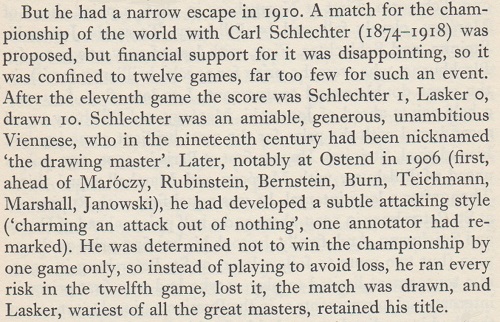
The writer of these references to 12 games, instead of ten, in the 1910 Lasker v Schlechter match was B. Goulding Brown. The quoted remark about ‘charming an attack out of nothing’ was on page 218 of Lasker’s Chess Magazine, August-September 1906, in a note to Schlechter’s 29...c5 against Rubinstein, Ostend, 1906:
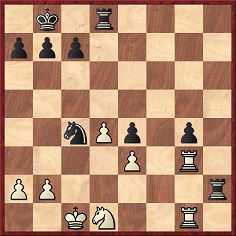
Position after 29 Nf2-d1
(11407)
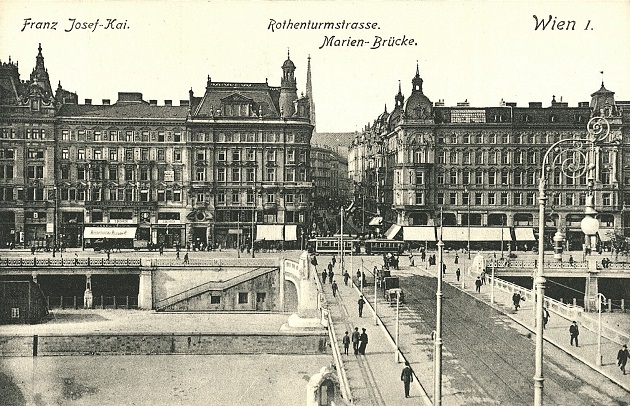
Michael Lorenz writes:
‘This 1909 postcard, from the holdings of the Austrian National Library, shows the view from Vienna’s Marienbrücke towards the Rotenturmstraße. On the right-hand corner of Rotenturmstraße and Franz-Josefs-Kai is the Café Marienbrücke (also called the “Café Schwarz”), which was the venue, between 17 and 24 January 1910, for the fourth and fifth games of the Lasker v Schlechter match. The first-floor rooms where both games were played are above the white awning. The whole first row of buildings near the Donaukanal was destroyed during combat in April 1945. The area where the Café Marienbrücke was located is now a park and a parking lot.’
(11601)
Addition on 24 August 2020: Olimpiu G. Urcan (Singapore) provides a photograph published on page 51 of Az Érdekes Ujsag, 26 December 1918 (the day before Schlechter died):
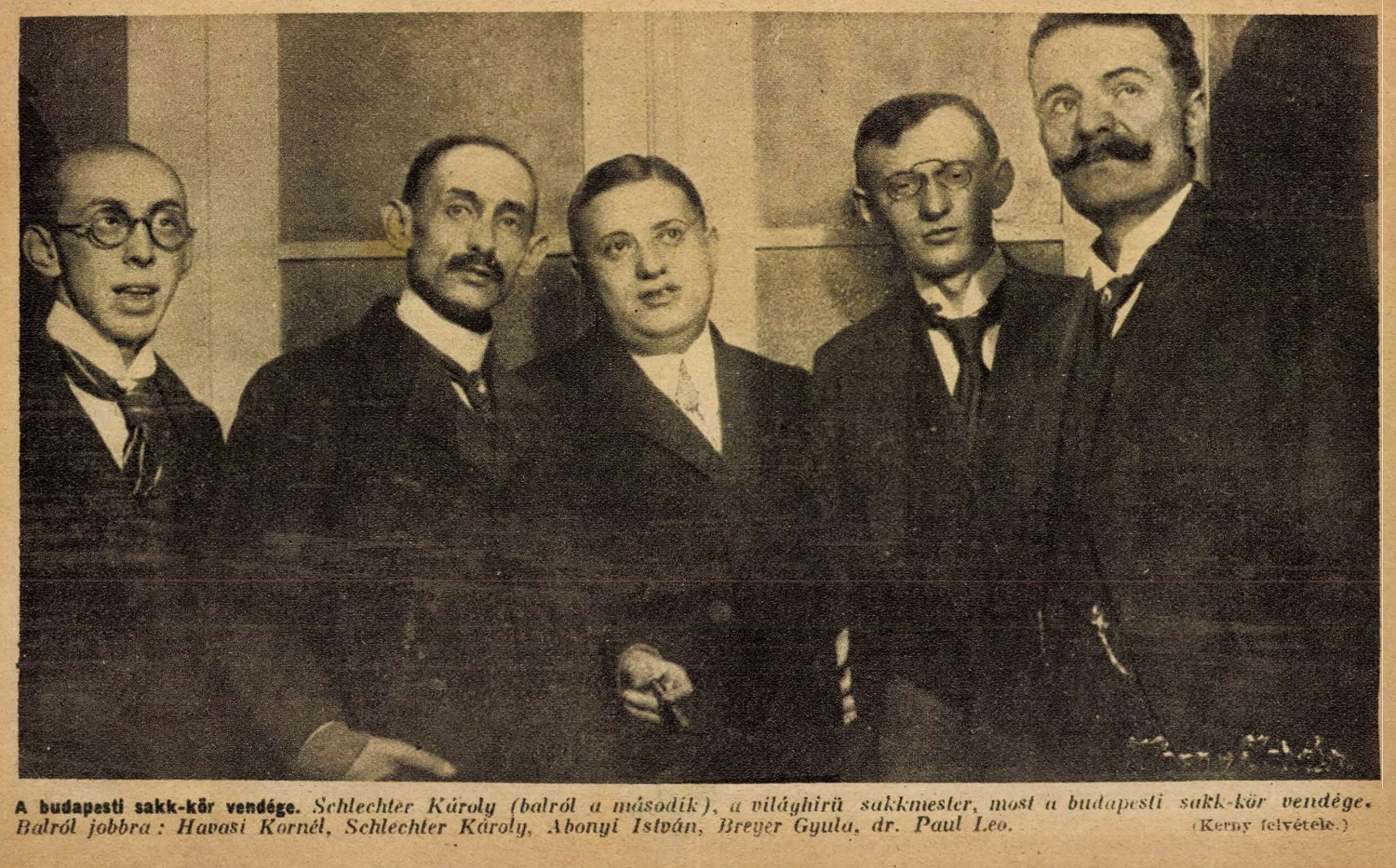
In a letter to us dated 13 January 1995 Dale Brandreth (Yorklyn, DE, USA) referred to a ‘vitriolic diatribe’ by James Schroeder on the above-mentioned Schlechter book by Warren H. Goldman. Dr Brandreth, the publisher, told us (after strongly criticizing Schroeder):
‘In my view Goldman does not do full justice to the belief that Hooper, Whyld and I share that there was indeed a “plus two” condition. It has always irked me that both Apps’ article in CHESS and the article by Blair in the BCM got so much praise when in my view both have grave shortcomings both from the standpoint of reasoning and proper attribution of sources. If I can ever get to it, I want to do a match book for L-S 1910 and in addition to full notes will give evidence indirectly from Lasker himself via Ed. Lasker to Buschke to Wilson and myself which says that there was a “plus two” condition. There is also a Schlechter letter which hinted at the same, but never said it outright.’
Following publication of his contribution to the 3/1995 issue of New in Chess, mentioned earlier in the present article, Dr Brandreth wrote to us on 13 July 1995:
‘I think New in Chess closed out the Lasker-Schlechter controversy. I should have also mentioned in my letter that although those who believe there was no two-point condition constantly remind everyone that no such published statements that there was such a condition are known before the 1970s (wrong there too since the plus-two condition was already referred to for the actual match in the Russian Chess Dictionary back in 1964 or the Zak book on Lasker in 1963 to name but two), they conveniently ignore the fact that they have yet to show any published statement of the actual conditions of the match.’
The relevant part of a letter to us dated 6 March 1992 from Warren Goldman:

(11844)
From Chess Thoughts:
A good historian knows when to be a waverer.
To the Chess Notes main page.
To the Archives for other feature articles.
Copyright: Edward Winter. All rights reserved.